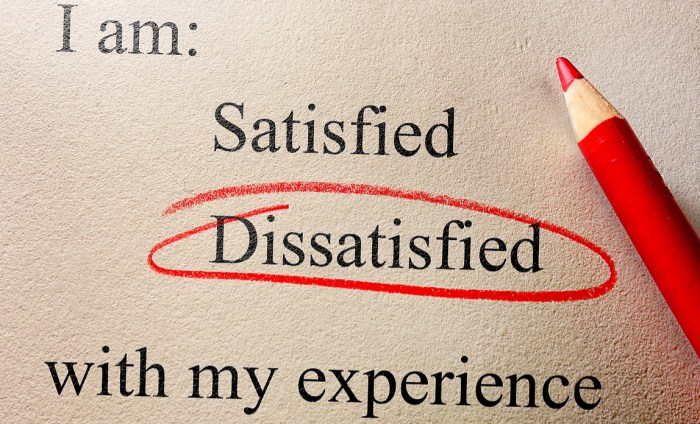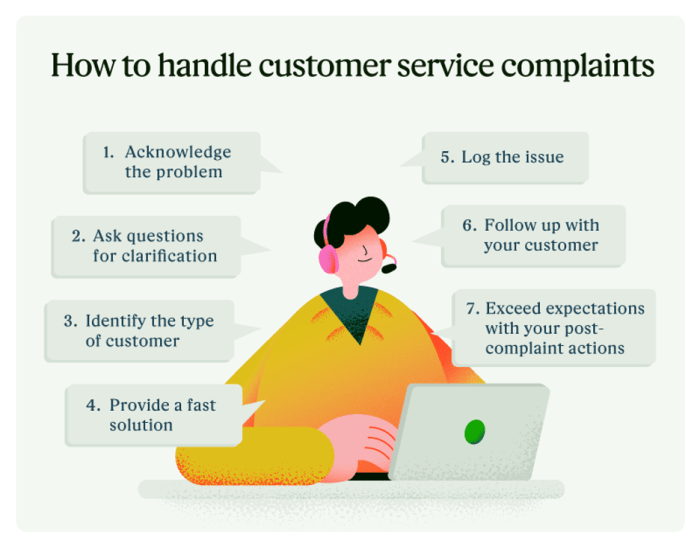Handling Customer Feedback sets the stage for business success, diving into the importance of customer input and effective strategies for collection and analysis. Get ready to master the art of feedback management!
Exploring the impact of customer feedback on brand reputation, the methods for collecting feedback, and the key steps to implementing changes based on valuable insights.
Importance of Handling Customer Feedback

Customer feedback is like gold for businesses looking to grow and improve. By listening to what customers have to say, a company can identify areas for enhancement, innovation, and overall customer satisfaction. Ignoring or mishandling feedback can lead to missed opportunities for growth and improvement.
Impact of Customer Feedback on Brand Reputation
Customer feedback plays a significant role in shaping a company’s brand reputation. Positive feedback can boost a brand’s image, attract new customers, and increase loyalty among existing ones. On the other hand, negative feedback, if not addressed properly, can tarnish a brand’s reputation and drive customers away. Companies that actively engage with feedback and make necessary changes demonstrate their commitment to customer satisfaction, which in turn enhances their brand reputation.
Examples of Companies Excelling in Handling Customer Feedback
1. Amazon
The e-commerce giant is known for its customer-centric approach and efficient handling of feedback. Amazon’s customer service team is quick to respond to queries and complaints, resolving issues promptly and effectively.
2. Apple
Apple has a dedicated feedback mechanism through its website and stores, allowing customers to provide input on products and services. The company uses this feedback to make improvements and innovations, strengthening customer loyalty.
3. Starbucks
Starbucks actively seeks feedback from customers through surveys, social media, and in-store interactions. The coffee chain uses this feedback to enhance the customer experience, introducing new products and services based on customer preferences.
Strategies for Collecting Customer Feedback: Handling Customer Feedback
When it comes to collecting customer feedback, there are several strategies that businesses can employ to gather valuable insights from their customers. It is crucial to actively listen to what customers have to say and encourage them to provide feedback in order to improve products and services.
Methods for Collecting Customer Feedback
- Surveys: Creating online or in-person surveys can help gather structured feedback from customers about their experiences with a product or service.
- Feedback Forms: Providing feedback forms on websites or in-store can allow customers to share their thoughts and suggestions easily.
- Social Media Monitoring: Keeping an eye on social media platforms for mentions, reviews, and comments can provide real-time feedback from customers.
The Importance of Active Listening
Active listening involves paying close attention to what customers are saying, showing empathy, and responding appropriately. By actively listening to customer feedback, businesses can better understand their needs and preferences, and make necessary improvements to enhance customer satisfaction.
Tips for Encouraging Customers to Provide Feedback
- Offer Incentives: Providing rewards or discounts for completing surveys or feedback forms can incentivize customers to share their opinions.
- Make it Easy: Ensure that providing feedback is simple and convenient for customers, whether through online forms, email surveys, or social media channels.
- Show Appreciation: Acknowledge and thank customers for their feedback, showing that their opinions are valued and taken into consideration.
Analyzing Customer Feedback
Customer feedback is a goldmine of information for businesses looking to improve their products or services. Analyzing this feedback involves digging deep to uncover trends and patterns that can guide decision-making and drive positive changes.
Identifying Trends and Patterns
Analyzing customer feedback begins with sorting through the data to identify common themes, issues, or suggestions that emerge across multiple responses. By looking for patterns, businesses can pinpoint areas that are consistently highlighted by customers, whether positive or negative.
- Utilize text analytics tools to categorize feedback into topics or themes.
- Look for recurring s or phrases that indicate common sentiments among customers.
- Create visual representations such as word clouds or sentiment charts to visualize trends.
Sentiment Analysis Techniques
Sentiment analysis is a powerful tool for understanding the emotions and attitudes expressed in customer feedback. By categorizing responses as positive, negative, or neutral, businesses can gauge overall satisfaction levels and identify areas for improvement.
Tools like Natural Language Processing (NLP) algorithms can automatically analyze the tone and sentiment of customer comments.
- Use sentiment analysis software to assign sentiment scores to individual feedback responses.
- Analyze the distribution of positive and negative sentiments to gauge overall customer satisfaction levels.
- Track sentiment trends over time to measure the impact of changes implemented based on feedback.
Implementing Changes Based on Feedback
Businesses that effectively analyze customer feedback can use the insights gained to drive meaningful changes that resonate with their target audience. By acting on feedback, companies can demonstrate their commitment to customer satisfaction and foster loyalty among their customer base.
- Identify key areas for improvement based on analysis of feedback trends.
- Develop action plans to address common issues or suggestions raised by customers.
- Communicate with customers about the changes implemented in response to their feedback to show responsiveness and appreciation.
Responding to Customer Feedback

Responding to customer feedback is a crucial part of maintaining a positive relationship with your customers. Whether the feedback is positive or negative, how you respond can greatly impact how your customers perceive your brand.
Best Practices for Responding to Customer Feedback
- Always respond promptly to customer feedback, whether it’s positive or negative. This shows that you value their input and are committed to addressing their concerns.
- Personalize your responses by addressing the customer by name and acknowledging the specific feedback they provided. This shows that you are listening and care about their individual experience.
- Express gratitude for positive feedback and apologize sincerely for any negative feedback. This shows that you are appreciative of their support and are willing to make things right if they are unhappy.
- Offer solutions or next steps when responding to negative feedback. Show that you are proactive in resolving issues and improving the customer experience.
Importance of Timeliness in Responding to Customer Feedback
Responding to customer feedback in a timely manner is key to showing customers that their opinions matter to you. Whether the feedback is positive or negative, addressing it promptly demonstrates that you are committed to customer satisfaction and are proactive in making improvements. By responding quickly, you can also prevent any negative sentiment from escalating and potentially harming your brand reputation.
Implementing Changes Based on Customer Feedback
When it comes to implementing changes based on customer feedback, companies must be proactive and responsive to meet customer needs and expectations. This involves analyzing feedback, identifying areas for improvement, and making necessary adjustments to products or services.
Examples of Successful Implementation
- Apple: Apple famously improved the battery life of their iPhones after receiving feedback about shorter battery performance from customers. This change resulted in higher customer satisfaction and increased sales.
- Amazon: Amazon implemented a more streamlined return process based on customer feedback, making it easier and quicker for customers to return products. This change led to improved customer loyalty and retention.
Challenges in Implementation, Handling Customer Feedback
- Resistance to Change: Some businesses may face internal resistance when implementing changes based on customer feedback, especially if it requires significant operational adjustments.
- Resource Constraints: Limited resources, such as budget or manpower, can pose challenges in implementing changes effectively and efficiently.
Strategies for Communicating Changes to Customers
- Transparency: Be transparent with customers about the changes being made and the reasons behind them. This builds trust and shows that you value their feedback.
- Feedback Loop: Create a feedback loop where customers can provide input on the changes and feel heard throughout the process.
